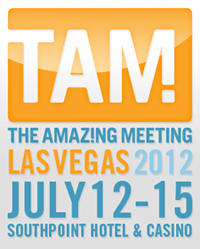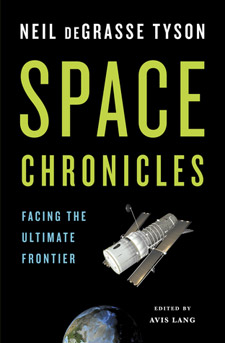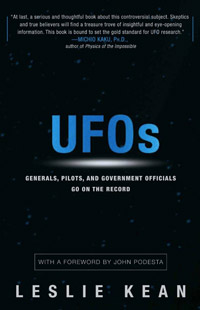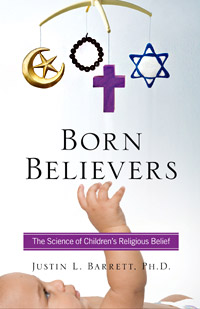In this week’s eSkeptic:
- Announcing The Amaz!ng Meeting 2012: July 12–15 in Las Vegas
- Follow Michael Shermer: A Report from the Reason Rally
- MonsterTalk: What the Bigfoot market will bear
- Skepticality: Interview with Neil DeGrasse Tyson
- Feature Article: Best Evidence for UFOs (a book review)
- Our Next Lecture at Caltech: The Science of Children’s Religious Belief
Announcing The Amaz!ng Meeting 2012
Southpoint Hotel & Casino, Las Vegas, NV
July 12–15, 2012
THE AMAZ!NG MEETING (TAM) is an annual celebration of science, skepticism and critical thinking. People from all over the world come to TAM each year to share learning, laughs and the skeptical perspective with their fellow skeptics and a host of distinguished guest speakers and panelists.
The James Randi Educational Foundation (JREF) has hosted its annual Amaz!ng Meeting since 2003 as a way to promote science, skepticism and critical thinking about paranormal and supernatural claims to the broader public. TAM has been held in Las Vegas, NV since 2004 and has become the world’s largest gathering of like-minded science-advocates and skeptics.
With yet another incredible lineup of speakers, hands-on workshops, and entertainment, this is sure to be an Amaz!ng Meeting you won’t want to miss! Check out the entire program, and follow @jref on Twitter for the latest #TAM2012 news and announcements.

NEW ON SKEPTICBLOG.ORG
Reason Rally Rocks
In this week’s Skepticblog, Michael Shermer reports on his experience at the March 24, 2012 Reason Rally in Washington, DC: the largest gathering of skeptics, atheists, humanists, nonbelievers, and “nones” (those who tick the “no religion” box on surveys) in the world.
NEW IN THE READING ROOM
The Moral Arc of Reason
Read Michael Shermer’s speech given at the Reason Rally in Washington, D.C.
on March 24, 2012.

What the Bigfoot market
will bear
In the forests of Pennsylvania, on a dark September night, a trail-cam took a series of controversial pictures. The Bigfoot Field Researchers Organization (BFRO) still claims they show a juvenile Bigfoot. Skeptics claim the photos show a bear. Join the hosts of MonsterTalk as they discuss Bigfoot photos, fair-use and the economics of unusual photos.
About this week’s eSkeptic
In this week’s eSkeptic, George Michael reviews Leslie Kean’s book UFOs: Generals, Pilots, and Government Officials Go on the Record (Crown, 2010, ISBN13: 978-0307716842).
George Michael received his Ph.D. from George Mason University’s School of Public Policy. Currently, he is an associate professor of nuclear counterproliferation and deterrence theory at the Air War College in Montgomery, Alabama. Previously, he was an associate professor at the University of Virginia’s College at Wise. He is the author of five books, including Willis Carto and the American Far Right, Theology of Hate: A History of the World Church of the Creator, and Lone Wolf Terror and the Rise of Leaderless Resistance. In addition, his articles have been published in numerous journals.
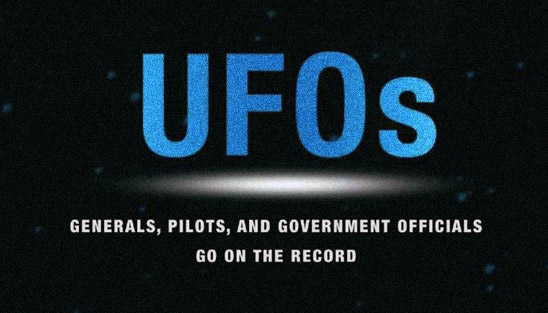
Best Evidence for UFOs
by George Michael
The study of UFOs has long been consigned on the fringes of the research community. Although the SETI (Search for Extraterrestrial Intelligence) project is regarded as a serious scientific effort, Ufology suffers from a sizable credibility gap despite the fact that nearly 80 percent of those Americans surveyed—according to a CNN poll conducted in 1997—believed that the government was hiding knowledge of the existence of alien life forms.1 The failure of Unidentified Flying Objects (UFOs) to be taken seriously in academia can be ascribed in large part to a dearth of physical evidence and the questionable reliability of UFO claimants. In UFOs: Generals, Pilots, and Government Officials Go on the Record, Leslie Kean, an investigative journalist, attempts to break with this pattern by relying on accounts from numerous credible eyewitnesses to UFO encounters and authoritative sources.
As Kean recounts, the contemporary UFO era commenced in the late 1940s after a sudden influx of sightings were observed in the United States and around the world. Concomitant with the start of the cold war, military officials began investigating UFOs, as they suspected that they might be Soviet in origin. In 1947, Lieutenant General Nathan Twining, commander of the Air Force Material Command, sent a secret memo concerning “Flying Discs” to the Pentagon and recommended that a detailed study into the topic was warranted. The next year, the “Sign” project was established within the Air Material Command with operations located at Wright Field (now Wright-Patterson Air Force Base). Sign was later renamed “Grudge” and in 1951 “Project Bluebook” became a repository for UFO cases and a place for people to call and file reports of sightings.
Other agencies took an interest in UFOs as well. In 1953, the Central Intelligence Agency (CIA) convened a scientific advisory panel chaired by H.P. Robertson, a physicist and weapon systems specialist from the California Institute of Technology. The panel proposed the creation of a broad educational program that would integrate the efforts of all concerned agencies. The CIA encouraged all agencies within the intelligence community to work with the media and infiltrate civilian research groups for the purpose of debunking UFOs. By doing so, public interest in the topic would diminish.
Some researchers, however, took issue with the government’s agenda to discredit UFO claims. For example, J. Allen Hynek, an astronomer who worked for a number of years as a consultant to Project Blue Book, released a book in 1972 titled The UFO Experience: A Scientific Inquiry, in which he acknowledged that the Air Force followed the CIA’s lead in debunking UFO claims. But UFO sightings continued, and in 1966 the University of Colorado agreed to host a government-funded study of UFOs led by Edward U. Condon, a prominent physicist and head of the National Bureau of Standards. The Condon Report concluded that “Nothing has come from the study of UFOs in the past twenty years that has added to scientific knowledge.” Project Bluebook was officially terminated in early 1970, thus ending all official government investigations into the topic of UFOs. Thereafter the UFO question shifted to the margins.
Although Project Bluebook was officially terminated, Kean believes that the U.S. military continues to investigate UFOs. She claims to have acquired a British government document from a Freedom of Information Act (FOIA) request that comes close to verifying the existence of a secret group in the U.S. intelligence community that still investigates UFOs. Despite the U.S. government’s dismissal of the validity of UFO sightings, according to Kean, documents released under FOIA show that officials in multiple branches of government asserted that the UFOs might be extraterrestrial in origin.
Compellingly, a significant proportion of UFO sightings have been reported by military pilots and their crews. Kean cites the notable example of Parviz Jafari, a major in the Iranian Air Force, who in 1976 approached a luminous UFO that was observed over Tehran. Jafari claimed that he attempted to fire a Sidewinder missile at the UFO, but his equipment shut down and returned to normal only after his jet moved away from the object. Apparently, the U.S. government took an interest in the case, as a once-classified memo from the Defense Intelligence Agency on the incident was sent to the National Security Agency (NSA), the White House, and the CIA. Another purported military encounter with a UFO occurred on April 11, 1980, when Lieutenant Oscar Santa Maria Huertas of the Peruvian Air Force was ordered to intercept what was initially believed to be an aerial spying balloon. He fired a 64-round burst of 30 mm shells that would normally obliterate a target, but the barrage had no effect. The bullets seemed to be absorbed by the object, which ascended very rapidly away from the air base. When Huertas got close to his target, he realized that it was not a balloon after all, but appeared to be an object with a shiny dome on top. As he explained, the object lacked the typical features of an aircraft, as it had no wings, propulsion jets, exhausts, or windows.
Perhaps the most notable reported military case involving a UFO occurred on December 26, 1980, at the Rendlesham Forest, near Ipswich in England. A three-man patrol from the U.S. Air Force’s 81st Security Police Squadron reported seeing a triangular-shaped metallic craft moving through the trees, which eventually landed in a small clearing. According to his account of the incident, upon approaching the craft, Sergeant James Penniston observed strange markings that he likened to Egyptian hieroglyphs. He even touched the craft and took photographs of it. After about 45 minutes he said the craft lifted off and maneuvered through the trees at a remarkable speed. Alas, the Air Force later told Penniston that his photos were overexposed and did not come out. However, depression marks where the object had landed were observed and a Geiger counter indicated significantly high radiation readings. Two nights later, the deputy base commander Lieutenant Colonel Charles I. Halt observed the craft as well and became one of the highest-ranking military officers ever to go on the record about a UFO sighting.
After many years of study, the U.S. military concluded that UFOs posed no threat to national security. Only a small fraction of UFOs have demonstrated even a remote semblance of hostility. And those rare occasions occurred only after severe provocation, such as an attack by military aircraft. According to several accounts, UFOs were able to evade attacks at the very last moment just when pilots locked onto their targets. Inasmuch as these last-minute evasions were so perfectly-timed, the pilots concluded that they could not be coincidental.
Numerous civilian accounts of UFO sightings that have surfaced are documented by Kean as well. For instance, the Hudson Valley wave, which began in upstate New York and parts of Connecticut in 1982, involved repeated sightings of large silent objects hovering at low altitudes with extremely bright spotlights. Even more significant was the case of the “Phoenix Lights,” which included a number of spectacular sightings that were reported in Arizona on March 13, 1997. Scores of witnesses claimed to have seen a massive aircraft measuring the size of “multiple football fields.” As is often the case, the government did not appear interested in the episode and no official investigation was launched despite the public outcry from the scores of eyewitnesses. A few months after the sightings, Governor Fife Symington announced at a press conference that he would reveal the source of the Phoenix Lights, whereupon his chief of staff, Jay Helier, was escorted to the podium in handcuffs and wearing an alien mask over his head. In a remarkable essay provided to Kean, Symington revealed that he too had seen the UFO, but explained that his levity at the press conference was as an effort to allay the consternation of his constituents.
Kean characterizes the U.S. government as a “pariah” on the international scene concerning official UFO investigations for its lack of transparency. In contrast, several European and South American governments have taken the issue seriously and established agencies to investigate to study of UFOs. In particular, Kean commends the French government for its open-mindedness on UFOs as evidenced by its creation of GEIPAN, a unit in the French space agency (CNES) that investigates unidentified aerial phenomena (UAP). In 1999, a private French group—COMETA (the committee for In-Depth Studies)—released a 90-page document that concluded that the best explanation for the small number of seemingly inexplicable UFO cases was the extraterrestrial hypothesis. Inasmuch as the report was undertaken by numerous retired generals, scientists, and space experts who spent three years analyzing military and pilot encounters with UFOs, it had considerable credibility. One of the report’s authors, Jean-Jacques Velasco, who from 1983 to 2004 led GEIPAN, concluded that the existence of UFOs was without question.
After a wave of UFO sightings were recording in Belgium in 1989-1990, the Belgian government took an interest in the topic as well. Approximately, 2,000 cases were reported of which 650 were investigated and 500 remain unexplained. Some observers described the aircraft as triangular, while other described them as massive inverted aircraft carriers. Several witnesses observed the craft making tilting maneuvers, which revealed a dome at the top. Belgian Major General Wilfried De Brouwer maintained that the maneuvers of the UFOs were beyond the capacity of even experimental aircraft and no “black program” could have been responsible for the sightings. Moreover, American authorities assured the Belgian Air Force that there were no U.S. aerial test flights that could have occasioned the sightings.
Despite numerous recorded incidents, Kean points out that many people dismiss the subject of UFO as something that is unserious and not worthy of study. Ostensibly, the U.S. government appears to be aloof on UFOs despite the documentary evidence. Still, some officials have taken the topic seriously. For example, shortly after assuming office, President Jimmy Carter (who had his own UFO sighting in 1969), instructed his science advisor, Frank Press, to write a memo to the National Aeronautics and Space Administration (NASA), recommending that the agency set up a panel of inquiry on UFOs. However, after a number of letters, memos, and inquiries made their way through the various levels of the hierarchy of the NASA bureaucracy, the agency turned down the president’s request in December 1977. For his part, Senator Barry Goldwater (Rep-AZ), a former pilot and retired major general in the Air Force Reserve, was convinced that a secret UFO program did exist. He once called the commander of the Strategic Air Command, Curtis LeMay, and asked permission to access the room at Wright-Patterson where information on UFOs resided, at which point LeMay alleged got angry and cussed him out, exclaiming “Don’t ever ask me that question again.” More recently, John Podesta, who served as President Bill Clinton’s White House chief of staff, wrote a foreword to Kean’s book and supported her efforts to bring more information on the topic of UFOs.
Why, Kean asks, is there such a strong taboo against taking the UFO subject seriously when there is so much evidence for it? Rather than an intentional conspiracy, Kean speculates that the U.S. government might be as baffled as everyone else on the UFO question. In an interesting essay included in the book titled “Militant Agnosticism and the UFO Taboo,” two political scientists, Alexander Wendt and Raymond Duvall, advance a theory as to why the U.S. government has supposedly been less than forthcoming on the UFO question. As they point out, skeptics cite a number of seemingly intractable obstacles to interstellar travel to argue against the extraterrestrial hypothesis. Nevertheless, Wendt and Duvall argue that the origins of the UFO taboo are political, not scientific. As they see it, the prospect of UFOs presents three major challenges to the sovereignty and credibility of the state. First, if UFOs are accepted as truly unidentified, then that proposition would acknowledge a potential threat, which could undercut the legitimacy of the state insofar as protection against potential threats is the most elemental function of the government. Second, a confirmation of the presence of UFOs would create tremendous pressure for a world government that today’s territorial states would be reluctant to form. Third, and most important, the extraterrestrial possibility would call into question the anthropocentric model of modern sovereignty, which as they explain, forms the basis of the authority of states to command the loyalty of their subjects. The arrival of extraterrestrial aliens, they assert, would be something analogous to the Christian “Second Coming.” In such a scenario they ask, to whom would people give their loyalty? Could states survive if such a question became salient?
In sum, Wendt and Duvall argue that the presence of UFOs creates a deep, unconscious insecurity in which certain possibilities are unthinkable because of their political implications. As a consequence, the taboo emerges not so much from a vast conscious conspiracy seeking to suppress “the truth” about UFOs. Rather countless undirected practices that help us “know” that UFOs are not extraterrestrial in origin and can therefore be disregarded are carried out by the government, but not in the style of a covert conspiracy.
The consensus among the researchers cited in the book is that 95 percent of UFO sighting can be explained by earthly sources. However, the other 5 percent cannot be attributed to secret military exercises or natural phenomena. The witnesses maintain that the UFOs appear to make exceptional performance maneuvers that are beyond the capabilities of know aircrafts. Moreover, they insist that they are guided by some intelligence.
Kean endorses Wendt’s and Duvall’s call for a “militant agnosticism” in pursuit of UFO investigations. By agnostic, they mean not rushing to ascribe UFOs to extraterrestrial sources. If, however, the eyewitness accounts presented in Kean’s book are to be believed, then one would be hard pressed to conclude otherwise. Other explanations proffered in the past would be at least, or even more mind-boggling, such as time travelers, Nazi flying saucers from underground bases in Antarctica, or visitors from other dimensions. What is most compelling about Kean’s study is the number of seemingly credible and authoritative first person sources who go on the record for her with their positions on UFOs. None of them claimed to have experienced any repercussions from the government or men-in-black visitations.
Alas, despite the impressive case she makes, smoking gun evidence remains elusive. Moreover, there appears to be little to no corroborative evidence outside of UFO studies that would support the extraterrestrial hypothesis. As Kean concedes, there have been no deathbed confessions or willed documents from any government scientists or officials that have revealed the truth about special access programs on UFOs. Moreover, she points out that we have not seen any fantastic reverse-engineered military technology that might have been retrieved from captured UFOs, despite rumors to the contrary. Numerous memoirs of past presidents and other prominent leaders often reveal embarrassing details of their lives, but so far, none have provided any insight about their secret relationships with extraterrestrial representatives.
Furthermore, although Wendt and Duvall dismiss the notion of a “vast conscious conspiracy” on the part of the U.S. government that prevents information on UFOs from reaching the public, it is hard to see how otherwise an issue of such earth-shaking significance could be withheld. Instead, the world’s leaders seem to go about their day-to-day business and decision-making without considering the influence of extraterrestrial visitors, who if they were so magnanimous, might at least give us some advice on how to find alternatives to fossil fuels, considering their ability to master interstellar travel. As others have noted, contact with extraterrestrials would be a transformative event, yet if it has already occurred, the world’s leaders seem startling aloof and amazingly tight-lipped—a remarkable adherence to security protocol in an age of exposé journalism. At least from surface appearances, public officials do not seem to take into account the presence of aliens, with few exceptions. For instance, far from shunning the prospect of extraterrestrial life, in August 1996, President Bill Clinton enthusiastically announced that NASA scientists had found evidence for life on Mars in the form of microscopic features inside a meteorite recovered from Antarctica in 1984, though subsequent analysis chipped away at that conclusion.2
As well, even the detailed accounts provided by reliable sources lack credibility. In his April, 2011 column in Scientific American, for example, Michael Shermer deconstructs the above-mentioned UFO wave over Belgium in 1989–1990. Here is Belgian Major General Wilfried De Brouwer’s recounting of the first night of sightings: “Hundreds of people saw a majestic triangular craft with a span of approximately a hundred and twenty feet and powerful beaming spotlights, moving very slowly without making any significant noise but, in several cases, accelerating to very high speeds.” As Shermer notes: “But even seemingly unexplainable sightings such as De Brouwer’s can have simple explanations. It could simply have been an early experimental model of a stealth bomber (U.S., Soviet, or otherwise) that secret-keeping military agencies were understandably loath to reveal.” Shermer then compares De Brouwer’s narrative to Kean’s summary of the same incident: “Common sense tells us that if a government had developed huge craft that can hover motionless only a few hundred feet up, and then speed off in the blink of an eye—all without making a sound—such technology would have revolutionized both air travel and modern warfare, and probably physics as well.” Shermer notes how a “120-foot craft” becomes “huge,” how “moving very slowly” changes to “can hover motionless,” how “without making any significant noise” shifts to “without making a sound,” and how “accelerating to very high speeds” transforms into “speed off in the blink of an eye.” He notes that “This language transmutation—probably unintentional—is common in UFO narratives, making it harder for scientists to provide natural explanations.” Despite this significant shortcomings, Kean’s book is a welcome addition to the topic of UFOs, which heretofore, suffered from a lack of reliability and academic rigor. Kean advises that UFO cases should be investigated utilizing scientific techniques that evaluate physical evidence rather than relying exclusively on subjective eyewitness accounts. To that end, she calls for the creation of a small agency within the U.S. government to handle appropriate UFO investigations and coordinate with other countries and the scientific community. With the ubiquity of digital cameras and cell phones, there are now more opportunities for witnesses to capture UFOs in pictures which could be exciting, for as it still stands, the burden of proof is still on the UFO claimants.
References
- “Poll U.S. hiding knowledge of aliens,” CNN, June 15, 1997, http://articles.cnn.com/1997-06-15/us/9706_15_ufo.poll_1_ufo-aliens-crash-site?_s=PM:US.
- Paul Davies, The Eerie Silence: Renewing Our Search for Alien Intelligence. (Boston and New York: Houghton Mifflin Harcourt, 2010), pp. 61–62.
Order Skeptic back issues on the topic of UFOs ($6 each)
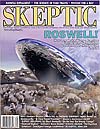
ROSWELL (10.1)
Buy it now
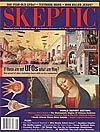
MEDIEVAL UFOs?
Buy it now
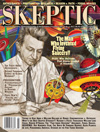
THE MAN WHO INVENTED FLYING SAUCERS
Buy it now
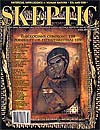
A.I. AND THEOLOGY
OF UFOs
Buy it now
Our Next Lecture at Caltech
Born Believers: The Science of Children’s Religious Belief
with Dr. Justin Barrett
Sunday, April 15, 2012 at 2 pm
Baxter Lecture Hall
FROM A NOTED DEVELOPMENTAL PSYCHOLOGIST and anthropologist at Oxford University, this fascinating theory about the value of religious faith posits that we are all predisposed to believe in God from birth. We are all Born Believers, explains Professor Justin L. Barrett. It begins in the brain. Infants, under the sway of powerful internal and external forces, make sense of their environments by imagining a creative and intelligent agent, a grand controller who makes the sun shine and the night fall. In the chaos of childhood, where so much is out of the child’s control, this belief in a morally good creator can bring tremendous comfort and calm. A child’s world is then filled with beings who intentionally act upon the environment, maintaining order. Summarizing scientific experiments conducted with children across the globe, Professor Barrett illustrates the ways human beings have come to develop complex belief systems about God’s omniscience, the afterlife, and the immortality of deities. He shows how the science of childhood religiosity reveals, across humanity, a “Natural Religion.”
TICKETS are first come, first served at the door. Seating is limited. $8 for Skeptics Society members and the JPL/Caltech community, $10 for nonmembers. Your admission fee is a donation that pays for our lecture expenses.
Followed by…
Subliminal: How Your Unconscious Mind Rules Your Behavior
with Dr. Leonard Mlodinow
Sunday, April 29, 2012 at 2 pm


